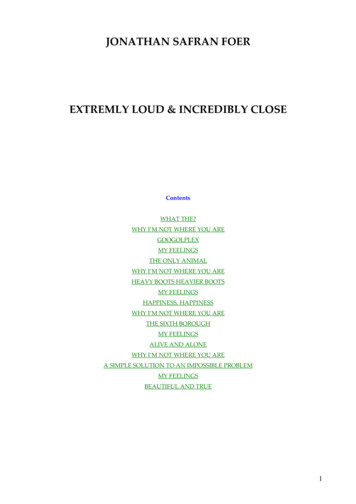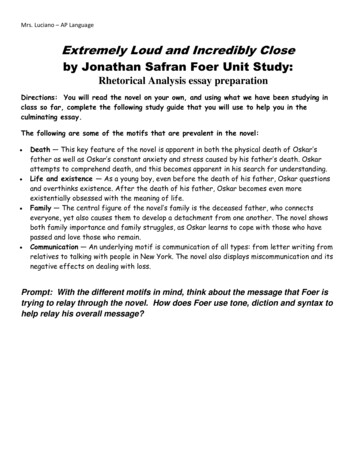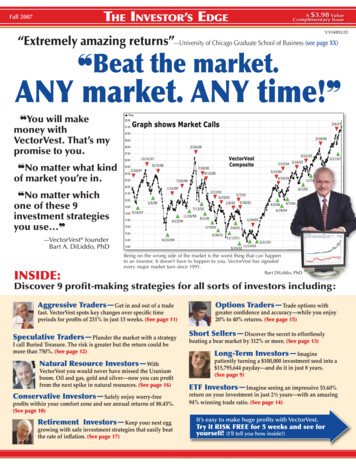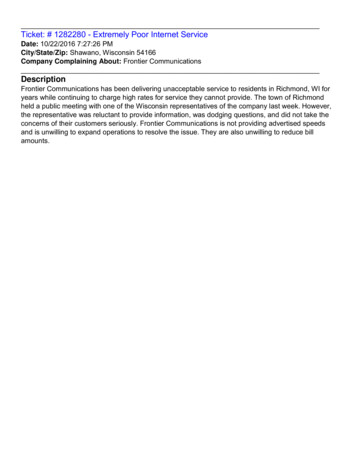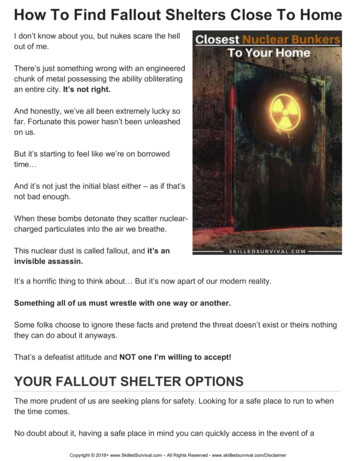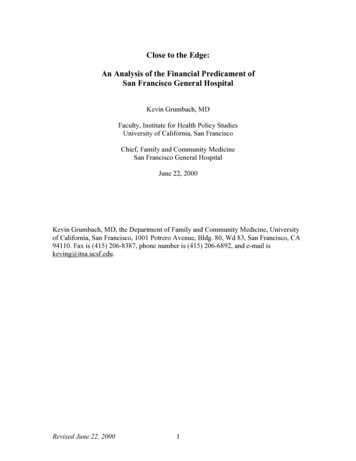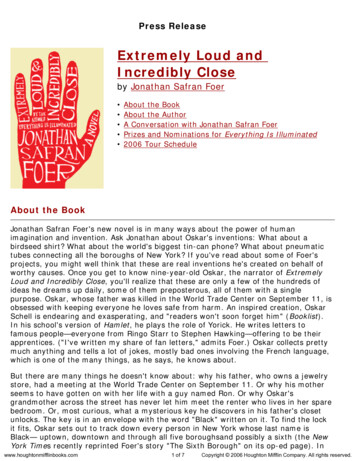
Transcription
Press ReleaseExtremely Loud andIncredibly Closeby Jonathan Safran Foer About the BookAbout the AuthorA Conversation with Jonathan Safran FoerPrizes and Nominations for Everything Is Illuminated2006 Tour ScheduleAbout the BookJonathan Safran Foer's new novel is in many ways about the power of humanimagination and invention. Ask Jonathan about Oskar's inventions: What about abirdseed shirt? What about the world's biggest tin-can phone? What about pneumatictubes connecting all the boroughs of New York? If you've read about some of Foer'sprojects, you might well think that these are real inventions he's created on behalf ofworthy causes. Once you get to know nine-year-old Oskar, the narrator of ExtremelyLoud and Incredibly Close, you'll realize that these are only a few of the hundreds ofideas he dreams up daily, some of them preposterous, all of them with a singlepurpose. Oskar, whose father was killed in the World Trade Center on September 11, isobsessed with keeping everyone he loves safe from harm. An inspired creation, OskarSchell is endearing and exasperating, and "readers won't soon forget him" (Booklist).In his school's version of Hamlet, he plays the role of Yorick. He writes letters tofamous people—everyone from Ringo Starr to Stephen Hawking—offering to be theirapprentices. ("I've written my share of fan letters," admits Foer.) Oskar collects prettymuch anything and tells a lot of jokes, mostly bad ones involving the French language,which is one of the many things, as he says, he knows about.But there are many things he doesn't know about: why his father, who owns a jewelrystore, had a meeting at the World Trade Center on September 11. Or why his motherseems to have gotten on with her life with a guy named Ron. Or why Oskar'sgrandmother across the street has never let him meet the renter who lives in her sparebedroom. Or, most curious, what a mysterious key he discovers in his father's closetunlocks. The key is in an envelope with the word "Black" written on it. To find the lockit fits, Oskar sets out to track down every person in New York whose last name isBlack— uptown, downtown and through all five boroughsand possibly a sixth (the NewYork Times recently reprinted Foer's story "The Sixth Borough" on its op-ed page). Inwww.houghtonmifflinbooks.com1 of 7Copyright 2006 Houghton Mifflin Company. All rights reserved.
the process of his search, Oskar befriends an array of odd characters, including a 103year-old war reporter and a tour guide in the Empire State Building who hasn't left thebuilding for decades.His search finally ends eight months later, in a meeting that is devastatinglyheartbreaking but, as Oskar would say, also beautiful and true. "It's hard to believethat such an inherently sad story could be so entertaining," writes Library Journal. Foerdoesn't confront only recent disasters. He takes the story back in history and far fromNew York. Extremely Loud and Incredibly Close encompasses other tragedies, equallyhorrendous: the bombing of Hiroshima and the destruction of Dresden, which Oskar'sgrandparents survived. Yet amid the darkness there is light. In Oskar we see ways toregain our humanity — our connection to one another — when all humanity seemsforsaken.Foer will be on national tour starting April 4. He continues to be involved in manyunusual projects, from the Pintchik Oracle (see the New Yorker piece) to communityart projects in Central Park (all involving people). Ask him about his unique use ofvisual elements in the novel. The book ends with "what is undoubtedly the mostbeautiful and heartbreaking flip book in all of literature" (Booklist). Discuss his otherprojects: writing a libretto for the Berlin Opera House or his political work for MoveOn.The movie of Everything Is Illuminated, directed by Liev Schreiber, is coming to the bigscreen this August. And film rights to Extremely Loud were snapped up by Scott Rudin.See and hear the author Jonathan Safran Foer discussing his work.About the AuthorJonathan Safran Foer was born in 1977. His first novel, Everything Is Illuminatedwas published by Houghton Mifflin in April 2002, excerpted in The New Yorker's annualdebut fiction issue, and translated into 26 languages. It quickly established itself as abestseller here and throughout Europe. A movie based on the book will be released inAugust 2005. It stars Elijah Wood as Jonathan Safran Foer, Eugene Hutz as Alex, withPeter Saraf as producer and Liev Schreiber directing. Foer has had stories published inThe New Yorker, The Paris Review, and Conjunctions. He is the editor of an anthologyof writing, inspired by A Convergence of Birds, the bird boxes of Joseph Cornell, andThe Future Dictionary of America, an anthology of words all Americans will need toknow in the coming years. These projects included more than 75 contributing authors,and all proceeds went to progressive groups such as MoveOn and the Sierra Club. Theforthcoming book Joe (fall 2005) is a collaborative art project between Foer, thesculptor Richard Serra, and the photographer Hiroshi Sugimoto. Additionally, Foer isworking on two public art projects, "The Whispering Parabolas" (in which two massiveparabolas will be built on opposite sides of the Central Park Reservoir to facilitateintimate conversations in the middle of Manhattan) and "10,000 Windows," incollaboration with students from La Guardia High School. Foer recently finished alibretto, "Seven Attempted Escapes from Silence," which was comissioned by theGerman National Operahouse in Berlin. The opera will have its premiere in September2005.www.houghtonmifflinbooks.com2 of 7Copyright 2006 Houghton Mifflin Company. All rights reserved.
Foer lives in Brooklyn, New York, and is currently at work on a new novel. WarnerBrothers and Paramount have jointly acquired the film rights to Extremely Loud andIncredibly Close. It will be produced as a feature film by Scott Rudin.A Conversation with Jonathan Safran FoerHow would you summarize your novel?Oskar Schell is an inventor, jewelry designer, amateur entomologist, Francophile,percussionist, avid fan-letter writer, pacifist, Central Park archeologist, romantic, GreatExplorer, jeweler, actor (Yorick in the winter production of Hamlet), inconsistent vegan,collector of: rare coins, butterflies that have died natural deaths, Beatles memorabilia,miniature cacti, and semi-precious stones. He is nine years old. After being let out ofschool on the morning of September 11, he walks home to his family's apartment onManhattan's Upper West Side. His watch reads 10:18:32. He listens to the fivemessages on the answering machine: from 8:52, 9:12, 9:31, 9:46, and 10:04. All arefrom his father, who is trapped in the World Trade Center. Before Oskar has time totime to figure out what to do, or even what to think or feel, the phone rings. His watchreads 10:22:29. He looks at the caller ID, and sees that it's his father. The storyproceeds from this moment, following Oskar in his efforts to make sense of his father'ssenseless death. That inward journey takes him through the five boroughs of NewYork, as he attempts to solve a mystery surrounding a key he discovers in his father'scloset, which he thinks is central to his father's life and death. The story moves freelybetween members of Oskar's family, careening from Central Park to Dresden, deepspace to Hiroshima, and ending, ultimately, where it began: at Oskar's father's grave.But this time it's the middle of the night. Oskar is accompanied by a strange man whohas been renting a room in his grandmother's apartment. They are there to dig upOskar's father's empty coffin. This is a novel of balances: humor and tragedy,destruction and invention, Something and Nothing, life and death.How did the idea for the novel originate?Very organically. It began with a museum, actually. A once-famous European writerdisappeared for forty years, and then reappeared. Over the course of successiverewrites — as my passions and sense of writing changed, and as the world changed —the novel was destroyed and rebuilt many times. The writer and museum fell by thewayside. A precocious young boy in a damaged city took center stage. I've written 39distinct drafts of this book. Like a boat whose every plank is replaced while journeyingat sea, the first and last drafts have nothing tangible in common — no characters,themes, or plot — and yet they are one in the same. To get to the 400 or so pages thatultimately comprise the novel, I had to write well over 2,500. Which is to say that theboat has been an aircraft carrier at times. It's been a volatile process.To make a long story short, I've tried to follow my instincts. I've tried to write the bookI would want to read, rather than the book I would want to write. I've tried never toask if something was smart, but instead if it felt genuine. A set of themes rose to thesurface: silence, invention, anxiety, naiveté, absence, the difficulty of expressing love,war . . . I felt I couldn't push them down, and I chose not to try. Voices becamewww.houghtonmifflinbooks.com3 of 7Copyright 2006 Houghton Mifflin Company. All rights reserved.
pronounced. Some characters became vivid, others vanished. A plot . . . happened. Ifit sounds inefficient, I've described it properly. I cannot imagine how I could have beenless efficient. But maybe inefficiency is the point. You can use a map and drive to adestination. Or you can follow the most interesting, beautiful roads — trusting yourself,trusting the car, and trusting the logic of the pavement — and end up where youcouldn't have realized you wanted to be until you got there. Writing, for me, is aboutfollowing roads. And that intuitive, wandering approach explains not only why this bookis so far from where I started, but why I feel it so personally, so viscerally, and so,well, loudly and closely.Where does the character of Oskar come from? Were you at all like him? Areyou still?My parents have a photograph of me on their refrigerator. I'm about six years old,asleep on the sofa, wearing a plaid blazer, a blue sequined bowtie, and rings on eachof my ten fingers. Apparently, the look was indicative of my sense of fashion for abouta year. That photograph was one of my major sources of inspiration for Oskar. As forhow much I actually was like him, it's hard to say. Like most children, I had a numberof collections. And I suppose my interests tended toward the esoteric, and my styletoward the precocious and annoying. I sent my share of fan letters, suffered numerousfailed attempts to kiss women my mother's age, and did work in the family jewelrybusiness for a summer . . . Am I still like that? Fortunately, or unfortunately, most ofOskar has been civilized out of me.Much of the novel has to do with war. What made you want to take this on asa subject matter?Of course the news has been saturated with the Iraq War. And before that the war inAfghanistan. And before that September 11. And there are so many other wars — bigand small — that receive less, if any, attention. There are wars within our country,between increasingly polarized ideologies, and within our households: intimate wars,wars within families, between lovers. Breakfast table wars. Silent wars. My generationof Americans has been among the most privileged in history in our ignorance ofmilitary war. Our sense of the armed forces was defined by benevolent actions thatmore often than not came too late — in Bosnia, in Rwanda. In other words, war,American war, was good. It's been a painfully disillusioning few years for mygeneration, not only because we've had to face malevolent wars, but because we'vehad to face our own foolishness. It's only now that we're able to digest the lessons anduse them. Toward what end? Toward the end of preventing war. There's a brief scenein the book in which Oskar plays an interview with a Hiroshima survivor. She says,"That is what death is like. It doesn't matter what uniforms the soldiers are wearing. Itdoesn't matter how good the weapons are. I thought if everyone could see what I saw,we would never have war anymore." Those words are loosely based on an actualinterview transcript, and I believe them. The more closely we look at something, themore responsible we will be with it. Which is why the most important decision anovelist can make is what he or she chooses to look at — insofar as there's a choice atall.www.houghtonmifflinbooks.com4 of 7Copyright 2006 Houghton Mifflin Company. All rights reserved.
The form of the book is quite new, particularly the use of photography. Howdid that come about?I was browsing the Internet one night — allowing links to carry me farther and fartherfrom the news sites I normally visit — and was shocked by the breadth andgraphicness of the images I quite unintentionally came across. I don't mean that in anaïve or prudish way. There's something exhilarating about being so close toeverything at once, something beautiful. But there's something incredibly lonely aboutit, too. And ugly. It made me think about children, and the visual environment in whichthey are now developing. What must it be like, as a nine year old, to see beheadings,and home videos of famous actresses having sex, and dogs fighting, and babies beingborn, and people jumping from planes with broken parachutes? Some of the images inthe novel pertain directly to Oskar's story, but many are there to provide context to hislife and give the reader access to a different kind of sympathy. That is, thephotographs show not only what Oskar's eyes might see, they show his eyes.What's the significance of the title?I like titles that contribute to the meaning of the book rather than describe the book'scontents. Which is to say I'm not going to have a great answer to this question, anymore than I'd be able to describe the significance of Oskar. Oskar is Oskar. The title isthe title. But that's a bit annoying. Maybe I could say that things in the novel are loudand close. War is loud and close — for Oskar's grandparents, who survived thefirebombing of Dresden, and for Oskar, who lost his father in the World Trade Centerattacks. The future is loud and close. Love is loud and close. And many things aresilent and far away. There are mute characters, and characters who can't hear.Characters who travel halfway around the world to be distant from those they love,and characters who endlessly wander the city in an attempt to get home. And thenthere are the things — like Oskar's relationship with his father — that aresimultaneously loud and silent, and close and far away . . . In reference to the novelitself, I hope the reader feels it loudly and closely. If I had a good voice, and all thetime in the world, I'd like to sing my thoughts and feelings directly into people's ears.Given that my voice is terrible, and time is limited — and who would want me thatclose to their face, anyway? — I write the best substitute I can.What are you working on now?I recently finished a libretto for the Deutsche Staatsoper (German National OperaHouse) titled, "Seven Attempted Escapes from Silence," and am now working with thedirector and set designer on bringing the words to the stage. (The opera will premier inSeptember 2005.) I'm also working on finishing up a collaborative art book, Joe, withthe sculptor Richard Serra and photographer Hiroshi Sugimoto, to be published thisfall. Finally, I've been working on two public art projects, "The WhisperingParabolas" (in which two massive parabolas will be built on opposite ends of theCentral Park Reservoir, to facilitate intimate conversations in the middle of Manhattan),and "10,000 Windows," in cooperation with the students of La Guardia High School.www.houghtonmifflinbooks.com5 of 7Copyright 2006 Houghton Mifflin Company. All rights reserved.
Prizes and Nominations for Everything Is IlluminatedWinner — Zoetrope All-Story Fiction Prize 2001Winner — National Jewish Book Award for Fiction 2002Winner — The Guardian Book Prize 2002 (U.K.)Winner — BGN Book of the Year 2002 (Holland)Winner — Premio letterario Adei Wizo 2002 (Italy)Winner — New York Public Library's Young Lions Fiction Award 2002Finalist — Los Angeles Times Book Award 2002Winner — William Saroyan International Prize for Writing 2002Winner — Harold U. Ribalow Award 2002Listed — Rolling Stone's People of the Year 2002Named — "Best and Brightest" writer by Esquire Magazine 2002Long listed — IMPAC Literary Award 2003Winner — Corine International Book Prize 2003 (Germany)Winner — PEN/Robert Bingham FellowshipWinner — Prix Amphi 2004 (France)2006 Tour ScheduleDENVERThe Tattered Cover, Historic LoDo — Mon., April 3, 7:30 pmNEW YORKMakor Talk (Steinhardt Building, 35 W. 67th Street) — Wed., April 5, 7 pmBarnes & Noble, Union Square — Mon., April 10, 7 pmAUSTINBarnes & Noble (10000 Research Blvd.) — Mon., April 17, 7 pmMILWAUKEEHarry W. Schwartz Bookshop (2559 N. Downer Ave.) — Tues., April 18, 7 pmCHICAGOBorders, Lincoln Park — Wed., April 19, 7 pmGoose Island Brewery: Wrigleyville (3535 North Clark Street) — Wed., April 19, 9:30pmBOSTONBrookline Booksmith Event at the Coolidge Corner Theater — Thurs., April 20, 6 pmLOS ANGELESSanta Monica Reads (Santa Monica College Pavilion) — Sun., April 23, 3:00 pmDutton's Brentwood — Mon., April 24, 7 pmSAN FRANCISCOA Clean Well-Lighted Place for Books — Tues., April 25, 7 pmCody's Books — Wed., April 26, 7:30 pmwww.houghtonmifflinbooks.com6 of 7Copyright 2006 Houghton Mifflin Company. All rights reserved.
PORTLANDPowell's City of Books (Burnside) — Thurs., April 27, 7:30 pmwww.houghtonmifflinbooks.com7 of 7Copyright 2006 Houghton Mifflin Company. All rights reserved.
Extremely Loud and Incredibly Close by Jonathan Safran Foer About the Book About the Author A Conversation with Jonathan Safran Foer Prizes and Nominations for Everything Is Illuminated 2006 Tour Schedule About the Book Jonathan Safran Foer's new novel is in many
